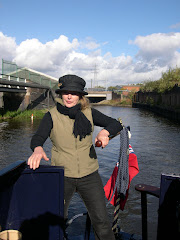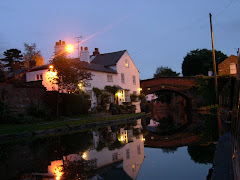The Oxford canal is not only shallow, but very narrow in places, it is no wonder that working boats weren't fond of using it. David Blagrove also mentions the us
 e of 'Banbury stick' to open and close the lift bridges in his book 'Bread On The Waters' as a time saving device when working a boat through them. Mind you, these days most of them have been removed or remain in the open position, which when not having to operate them, makes it easy to say 'what a pity'. I wonder if we would ever say that about the horrid swing bridges on the Leeds & Liverpool Canal?
e of 'Banbury stick' to open and close the lift bridges in his book 'Bread On The Waters' as a time saving device when working a boat through them. Mind you, these days most of them have been removed or remain in the open position, which when not having to operate them, makes it easy to say 'what a pity'. I wonder if we would ever say that about the horrid swing bridges on the Leeds & Liverpool Canal?Banbury has a lift bridge still in use, of course it does! It is in
 the centre of the museum and historic boatyard part of the town centre stretch. This one though is operated by windlass and much easier to open that the average lock paddle. Children seem to enjoy riding up and down the balance beam despite being admonished by a safety conscious Jeeves who was working the boat through at the time.
the centre of the museum and historic boatyard part of the town centre stretch. This one though is operated by windlass and much easier to open that the average lock paddle. Children seem to enjoy riding up and down the balance beam despite being admonished by a safety conscious Jeeves who was working the boat through at the time.This is a very busy bit of waterway, and on our return, we found ourselves negotiating firstly the lock, then watering up and passing back through the lift bridge all in the space of about two hundred yards. Meanwhile other boaters kept the lock and the bridge active, while teenagers sat around on steps at the entrance to the Castle Key shopping complex. This is a huge development about which I can't think of anything nice to say - except that the toilets were clean.
One
 good thing about Banbury is that there are plenty of good moorings right in the centre of town. It would appear the the Council has decided that their new development and picturesque surroundings replete with a footbridge over the canal and lot of canal-side seating, would be better enhanced by having boaters who really do move around and wish only to stay one or two days rather than 14 days to 14 years, turning the towpath into a sort of side garden for storing old household furniture and other rubbish carefully protected with bright blue plastic sheets.
good thing about Banbury is that there are plenty of good moorings right in the centre of town. It would appear the the Council has decided that their new development and picturesque surroundings replete with a footbridge over the canal and lot of canal-side seating, would be better enhanced by having boaters who really do move around and wish only to stay one or two days rather than 14 days to 14 years, turning the towpath into a sort of side garden for storing old household furniture and other rubbish carefully protected with bright blue plastic sheets.All being equal, it is rather splendid to be able to be
 able to moor up in the middle of such a historic town. last time we were here was 1997 and were besotted by the idea that the Oxford Canal ran through Banbury itself. Back then we were too interested in the canal to pay much attention to Banbury and left it to drive on to Braunston. We saw a lot more this time, although sadly the original cross has been replaced by a 19th. century version, part of the atmosphere remains, despite the Castle Key shopping mall. How's this for a wine shop? Very pricey though, annoyingly enough, the only off licence in the whole of Banbury - it was lucky that we didn't have to purchase anything until we returned to Cropredy, all wet rations safely aboard in the bond store.
able to moor up in the middle of such a historic town. last time we were here was 1997 and were besotted by the idea that the Oxford Canal ran through Banbury itself. Back then we were too interested in the canal to pay much attention to Banbury and left it to drive on to Braunston. We saw a lot more this time, although sadly the original cross has been replaced by a 19th. century version, part of the atmosphere remains, despite the Castle Key shopping mall. How's this for a wine shop? Very pricey though, annoyingly enough, the only off licence in the whole of Banbury - it was lucky that we didn't have to purchase anything until we returned to Cropredy, all wet rations safely aboard in the bond store. There are of course some magnificent old pubs in Banbury, but our favourite was the 'Ye Olde Reindeer', an Elizabethan pub dating from 1570 according to Michael Pearson. The staff were wonderfully friendly and recommend that we view the Globe Room where Oliver Cromwell held court while planning battles such as that of Cropredy Bridge. The whole room has been restored after being sold and left to collect dust in a London warehouse for many years. The original ceiling is still
of course some magnificent old pubs in Banbury, but our favourite was the 'Ye Olde Reindeer', an Elizabethan pub dating from 1570 according to Michael Pearson. The staff were wonderfully friendly and recommend that we view the Globe Room where Oliver Cromwell held court while planning battles such as that of Cropredy Bridge. The whole room has been restored after being sold and left to collect dust in a London warehouse for many years. The original ceiling is still missing. The landlord sent shivers down our spines when he told us that the whole room would have been sold to a collector in the United States, had the sale gone through. Anyway, it is back where it belongs now and looks every bit at good as it does in the paintings on the walls and in the corridors leading to the room.
missing. The landlord sent shivers down our spines when he told us that the whole room would have been sold to a collector in the United States, had the sale gone through. Anyway, it is back where it belongs now and looks every bit at good as it does in the paintings on the walls and in the corridors leading to the room.
 of course some magnificent old pubs in Banbury, but our favourite was the 'Ye Olde Reindeer', an Elizabethan pub dating from 1570 according to Michael Pearson. The staff were wonderfully friendly and recommend that we view the Globe Room where Oliver Cromwell held court while planning battles such as that of Cropredy Bridge. The whole room has been restored after being sold and left to collect dust in a London warehouse for many years. The original ceiling is still
of course some magnificent old pubs in Banbury, but our favourite was the 'Ye Olde Reindeer', an Elizabethan pub dating from 1570 according to Michael Pearson. The staff were wonderfully friendly and recommend that we view the Globe Room where Oliver Cromwell held court while planning battles such as that of Cropredy Bridge. The whole room has been restored after being sold and left to collect dust in a London warehouse for many years. The original ceiling is still missing. The landlord sent shivers down our spines when he told us that the whole room would have been sold to a collector in the United States, had the sale gone through. Anyway, it is back where it belongs now and looks every bit at good as it does in the paintings on the walls and in the corridors leading to the room.
missing. The landlord sent shivers down our spines when he told us that the whole room would have been sold to a collector in the United States, had the sale gone through. Anyway, it is back where it belongs now and looks every bit at good as it does in the paintings on the walls and in the corridors leading to the room.We had lunch there the following day, soaking up the atmosphere. Can't say much for the lunch though. All in all a lovely part of our history, set in a wonderful low beamed traditional pub.
Well, here is something Elisabethan to rub along with our visit to Banbury:
Ride a cock horse to Banbury Cross
To see a fine lady upon a white horse
With rings on her fingers and bells on her toes
She shall have music wherever she goes
The nursery rhyme was most likely related to a visit made by Queen Elizabeth in the 16th century. It is none the less rather evocative of an Oxfordshire town in those days. One one wonders what good Queen Bess would have made of seeing a canal running past the town centre.













